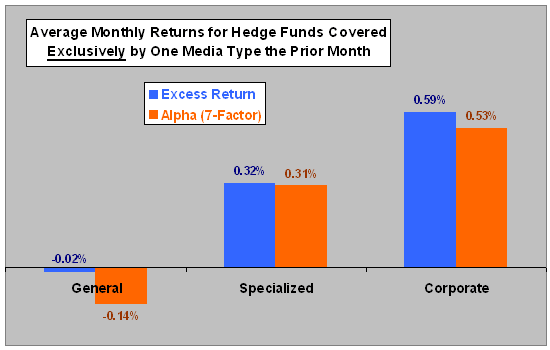Does media coverage of hedge funds indicate their values as investments? In their July 2010 paper entitled “Media and Investment Management”, Gideon Ozik and Ronnie Sadka investigate the level and investment implications of media bias by applying textual analysis to titles of articles from three types of news coverage about equity hedge funds (General newspapers, Specialized investment magazines, and Corporate communications). They frame their investigation by hypothesizing three aspects of bias: reporting style, editorial selection and content. Using the Google News archive to collect approximately 67,000 news articles from about 3,600 unique media sources on a sample of 774 long/short U.S. equity hedge funds over the period 1999-–2008, they find that:
- When multiple sources cover a hedge fund at the same time, sentiment is most positive in
Corporate coverage and least positive in General coverage (reporting style bias). - When coverage is exclusive within a given month, this difference in source sentiment is about twice as large (editorial selection bias).
- There appears to be a content bias in that, on average, funds covered exclusively by Corporate (General) media produce a positive (negative) return over the following year (see the chart below).
- These biases generally persist after controlling for hedge fund characteristics such as past returns and assets under management.
- Based on fund flow analysis, investors appear not to exploit media coverage as a sentiment indicator.
The following chart, constructed from data in the paper, summarizes average (equally weighted) monthly returns for groups of hedge funds formed each month based on exclusive coverage by each of the three media types the prior month. Returns by media type are similar whether measured simply in excess of the risk-free rate or adjusted for multiple risk factors common to long/short U.S. equity hedge funds.
Exclusive Corporate (General) media coverage tends to precede positive (negative) returns, with exclusive Specialized media coverage falling in between.

In summary, evidence indicates that hedge fund investors may be able to gain an edge by limiting consideration to funds with recent corporate releases but no other recent media coverage.
However, fund trading restrictions would likely limit systematic exploitation of media bias.